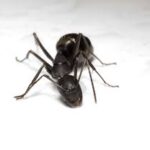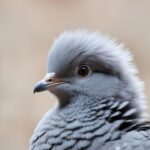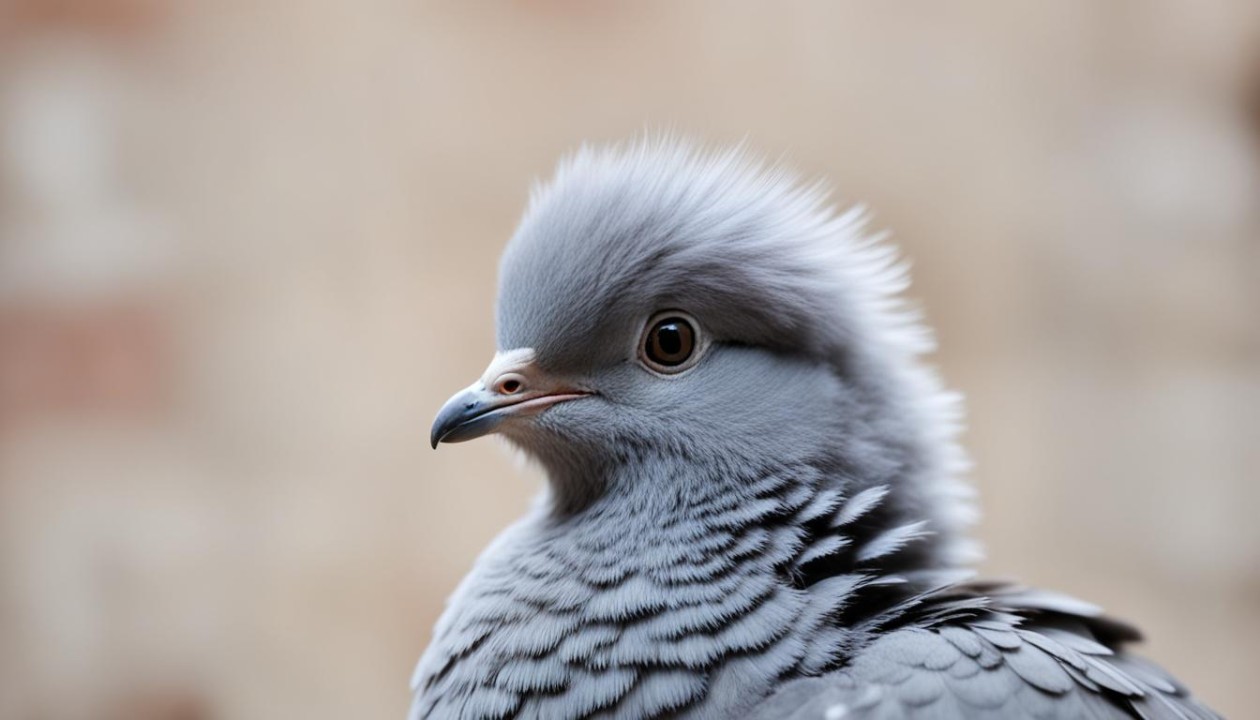When most people think of pigeons, they envision the familiar adults: sleek, colorful birds commonly seen in cities, parks, and on rooftops. However, one aspect of pigeon life often goes unnoticed—their babies. Commonly referred to as “squabs,” baby pigeons are quite different from their adult counterparts, and the mystery surrounding them has led to misconceptions. Why don’t we see baby pigeons often? How do pigeons raise their young? What makes a squab unique?
In this article, we will explore the life of a baby pigeon, from birth to fledgling, and debunk some of the common myths associated with these young birds. We’ll also cover pigeon parenting, their growth stages, diet, and how baby pigeons are raised in both wild and urban environments. Whether you’re an avid bird watcher or just curious about these fascinating creatures, this deep dive into the world of squabs will provide a comprehensive understanding of their development.

The Early Life of a Pigeon: Hatching and Birth
Pigeons are monogamous birds, meaning they typically mate for life. When a pair of pigeons decides to breed, the female lays one or two eggs, usually around the same time each year. Unlike many other birds, pigeons have relatively small clutches, often just one or two eggs per breeding cycle. After the eggs are laid, both the male and female pigeon take turns incubating them for about 17 to 19 days, keeping the eggs warm and protected from predators.
Once the eggs hatch, the baby pigeon, or squab, emerges. The hatchling is extremely vulnerable at this stage. Newborn pigeons are altricial, meaning they are born blind, featherless, and completely dependent on their parents for survival. At birth, the squab looks very different from the mature adult bird—its skin is pinkish and covered with a thin layer of soft, downy feathers.
Physical Development: From Hatchling to Juvenile
As the days pass, squabs begin to develop at a rapid pace. Within a few days, they start to grow their first feathers, and their eyes open. During the first few weeks of life, squabs are fed a substance called pigeon milk (or crop milk), a secretion produced by both parents in their crop (a part of the digestive system). This milk is rich in proteins and fats and provides all the nutrition the baby pigeon needs in its early weeks. Interestingly, pigeon milk is produced by both the mother and father, making pigeon parenting a true partnership.
Pigeon milk is not a milk-like substance in the sense that mammals produce milk. Rather, it is a semi-digested mixture of the parent’s food and secretions from the crop, designed to be high in energy to sustain the squab’s rapid growth. The parents regurgitate this milk directly into the squab’s mouth, feeding it multiple times a day.
Squabs remain in the nest, where they are protected by their parents, who take turns keeping watch, feeding, and keeping the baby warm. As they grow, squabs begin to develop more feathers, and they start to look more like adult pigeons, though their plumage is often a bit duller at this stage.
Nesting and Parental Care
Pigeon parents, known as the cock (male) and hen (female), share the responsibility of raising their young. After hatching, they remain closely involved in the care of the squab, ensuring it has the warmth, food, and protection it needs. The nest itself is typically a simple structure made of twigs, grass, and debris, which the pigeons build in a safe location, often high up in buildings, trees, or cliffs, to protect their eggs and chicks from predators.
Interestingly, pigeons tend to breed year-round in favorable environments, making them prolific breeders. A pair of pigeons can produce multiple broods in a year, with the interval between each brood being about 6-8 weeks. This high reproductive rate ensures that there are always baby pigeons, or squabs, in the world, even if they are not always visible.
Growth and Fledging: The Path to Independence
As squabs mature, their feathers become denser and more adult-like. By the time they reach 3 to 4 weeks of age, they start to practice basic flying skills by flapping their wings and exploring their surroundings. This stage is critical for developing the strength and coordination necessary for flight. Unlike some birds, pigeons do not immediately fly after leaving the nest. Instead, squabs begin to spend more time out of the nest, hopping around and exercising their wings in preparation for their first flight.
At around 4 to 6 weeks old, squabs are usually ready to make their first flight. This is when they are officially referred to as fledglings. They may still rely on their parents for food and care for a while, but gradually they learn to find food independently and eventually leave their parents’ care altogether.
Pigeons typically become fully independent by 6 to 8 weeks of age, though some may linger near their parents for a few additional weeks while refining their flying and foraging skills. After this period, the young pigeons, now considered adults, will begin searching for their own mates and establishing territories.
Why Don’t We See Baby Pigeons?
One of the most commonly asked questions about pigeons is: why don’t we see baby pigeons, or squabs, in the wild? This question often leads to the misconception that pigeons don’t have babies, or that they lay eggs that never hatch. The truth, however, is much simpler.
The reason we rarely see squabs is because they spend the majority of their early lives hidden in the nest, usually tucked away in high, secluded places where they are safe from predators. Since pigeons often nest in areas that are difficult for humans to access, like high ledges or under rooftops, we don’t get the opportunity to see them as babies. Additionally, the nesting period for pigeons is relatively short, so even if you were to spot a squab, it may be transitioning into a fledgling by the time you see it.
Another reason for the lack of baby pigeons in public view is that pigeons, unlike many other birds, don’t raise their young in large colonies. Instead, pigeons tend to nest in smaller, more secluded spots, which limits their exposure to the public eye. This behavior is in contrast to other bird species like seagulls or ducks, whose chicks are often visible in public spaces shortly after hatching.
Debunking Common Myths About Pigeons
There are many myths and misconceptions about pigeons, particularly when it comes to their babies. Here are a few common myths debunked:
1. Pigeons only have one egg at a time
While pigeons often lay a single egg or two per clutch, it’s not true that they only have one egg at a time. However, it is common for pigeons to lay two eggs in succession, with a brief interval between each one. Both eggs usually hatch within 24-48 hours of each other.
2. Baby pigeons are the same size as adults
Contrary to popular belief, baby pigeons (squabs) are not born fully developed like many other birds. They are quite small and helpless at birth and take several weeks to develop into adult-like birds. This is in stark contrast to the myth that baby pigeons are simply miniature versions of adults.
3. Pigeons don’t care for their babies
Pigeons are attentive parents. Both the male and female share the responsibility of incubating the eggs, feeding the squab with pigeon milk, and protecting the nest from potential threats. Far from neglectful, pigeon parents invest a lot of care and effort into ensuring the survival of their young.
4. Pigeons don’t need much parental involvement
Unlike some bird species that leave their young soon after hatching, pigeons remain highly involved in raising their squabs. They feed them, protect them, and provide them with warmth until they are ready to fly and fend for themselves.
Conclusion
The life of a baby pigeon, or squab, is fascinating and integral to the larger lifecycle of these resilient birds. From hatching in a cozy nest to gradually learning to fly, squabs undergo a rapid transformation. Though they are often hidden from view, pigeons’ early years are far from uneventful. The nurturing care they receive from their parents, combined with their rapid growth and development, equips them for life in a sometimes harsh world.
In urban areas, pigeons have adapted well to their environment, creating a niche where they are both revered and reviled. Despite their reputation as pests, pigeons’ fascinating life cycle, particularly their nurturing parenting and unique developmental stages, should be celebrated as a testament to the resilience and adaptability of nature.
FAQs
1. What is the lifespan of a baby pigeon?
Baby pigeons, or squabs, have the potential to live up to 15 years in the wild, though many pigeons in urban environments face challenges that may reduce their lifespan. Once a squab becomes a fully-fledged adult, its chances of survival improve significantly.
2. How long do pigeons stay in the nest?
Pigeons typically stay in the nest for around 4 to 6 weeks before they fledge and begin to fly. However, some may remain near the nest for a few more weeks as they refine their flying and foraging skills.
3. Do pigeons only mate with the same partner?
Yes, pigeons are generally monogamous and mate for life. Once they find a mate, they will continue to breed together for subsequent seasons.
4. Can pigeons care for their squabs alone?
Both the male and female pigeon share in the care of their squabs. The male incubates the eggs during the night, while the female takes over during the day, and both parents feed the squabs.
5. Why don’t we see baby pigeons in public spaces?
Baby pigeons spend most of their early lives hidden in the nest, often in high, secluded places that are difficult for humans to access. This explains why they are rarely visible in public areas.











